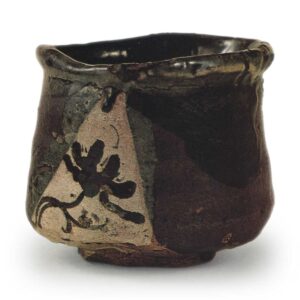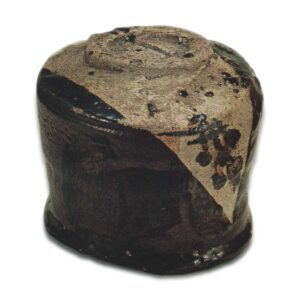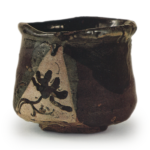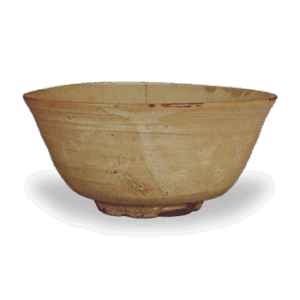

Height: 9.1cm
Diameter: 9.9-10.7cm
Height of foot ring: 5.1-5.8cm
Height of rim: 0.5cm
This is one of the most famous examples of Oribe tea bowls, and it is even more significant in the field of tea bowls because it has a history that has been passed down through the Hirase and Fujita families.
While most Oribe tea bowls are characterized by their so-called “shoe-shaped” appearance, this tea bowl is unusually cylindrical, and the way the rim is twisted and the foot is flared shows the distinctive Oribe deformation, but it still does not fall into the ordinary, and it is full of originality and has a lively feeling. This is a tea bowl that shows the style of the early Oribe tea bowls.
The natural flexibility of the height and width of the rim and the thickness and thinness of the body, as well as the sense of speed and slowness, are deeply attractive and are one of the highlights of this tea bowl.
In terms of the glaze, it is a rare example of a tea bowl that has been glazed with a mixture of persimmon and white glazes, known as “persimmon Oribe”, and is also a rare surviving example. The purple-tinged persimmon glaze was applied without the foot ring, and naturally triangular windows opened up in the front and back of the body, into which floral and plant designs were painted using a brush with a loose tip.
The view from the front is particularly wonderful, with the mouthwork being especially exquisite, and the overlapping of the white glaze and persimmon glaze, as well as the appearance of the black glaze in some places, all adding to the charm of the work. And the triangular window, which has been cut out in a vivid white, is extremely impressive. The beauty of the cast picture is also extremely high, and it is as if you are looking at a piece of ink painting in the darkness. It is rare to find a piece of pottery with such a strong painted effect.
Oribe black tea bowls are divided into two types: plain ones are called Oribe black, and those with window paintings are called black Oribe. While the latter generally tend to be more conventional in shape, the former, although already showing the distinctive Oribe-style deformation, are still full of lively and creative freedom. Generally speaking, Oribe-kuro tea bowls are thought to have been produced earlier than those in the Oribe-ori style.
However, this Oribe-tsutsumi tea bowl, despite having a window painting, is more akin to an Oribe-kuro tea bowl in terms of its production, and from this point of view, it can be called an extremely rare surviving piece. What is even more admirable is the overall appearance of the piece, which is rich in artistic flavor and of a high caliber, and it is probably not an exaggeration to call it not only a masterpiece of Oribe, but also one of the finest pieces among the many famous bowls of Mino Seto.
The rim has four marks that look like they were made by layering the glaze, which adds a certain charm to the piece, and there is a black brushstroke on the inside, which also adds to the appeal. The foot is carved out, and there are also brushstroke marks on the side, with black flecks of glaze scattered on top. Inside the foot, there is a brushstroke mark carved in the shape of the character “ichi” (meaning “one”).
The inscription on the inner box is by Sen Sōmori (Yūkōsai). It was passed down through the Hirase family, who were known as tea ceremony enthusiasts in Naniwa, and later passed to the Fujita family, who were also famous for their collection of tea utensils, but it was sold at auction and is now in the collection of the current owner.








